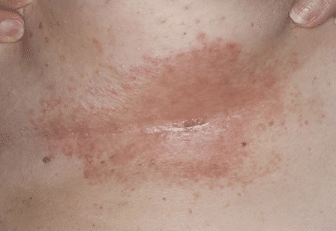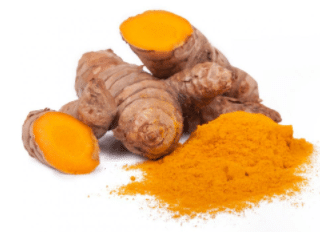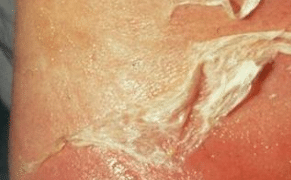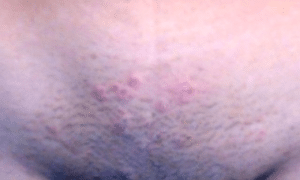Do you have dark patches on skin folds like under the breast and armpits? They may be itchy or not depending on the cause. In this post, we have insights into the causes of dark patches on skin and how to get rid of them using different remedies and treatment. You will also learn from the various pictures that are provided.
Dark Patches on Skin
Hyper-pigmentation is a common, harmless condition where the patches of skin can become darker in color than normal surrounding skin.
This darkening happens when excess melanin “the brown pigment which produces the normal skin color” usually forms deposits in the skin. Hyper-pigmentation may also affect the skin color of the people of any race.
Age spots are usually a common form of hyper-pigmentation. They happen because of sun damage and are known by doctors as the solar lentigines.
These very small, darkened patches are found on hands and face or any other areas that are frequently exposed to the sun.
Melasma spots are very similar in appearance to the age spots but are much larger areas of darkened skin which appear due to the hormonal changes.
Pregnancy, for instance, can be able to trigger overproduction of the melanin which leads to the “mask of pregnancy” on the face and also the darkened skin on the abdomen and several other areas.
Women who normally take birth control pills can develop hyperpigmentation as their bodies undergo this kind of hormonal changes which happen during pregnancy. If one is bothered by pigment, the control pills should be stopped.
Changes in the skin color can emanate from outside causes. For instance, skin diseases like acne might leave dark spots after the condition clears. Other causes of the dark spots are injuries to the skin, including some of the surgeries.
Freckles are the small brown spots which appear anywhere on the body, but are common in the face and also the arms. Freckles are an inherited characteristic.
Freckles and other dark spots on skin may become darker or even more pronounced when the skin is exposed to the sun.
This occurs due to the fact that melanin absorbs the energy of sun’s harmful ultraviolet rays so as to protect the skin from overexposure.
The usual result of the process is skin tanning, which also tends to darken areas which are already hyper pigmented. Wearing of the sunscreen is a must. The sunscreen should be “broad spectrum”. A single day of the excess sun may undo months of treatment.
There are several highly effective laser treatments. The q-switched ruby and pigmented lesion lasers often get rid of the pigment without any scarring. A test spot in inconspicuous place will be required to be done as they make things to be worse instead of being better.
What Causes Dark Patches or Spots on the Skin
Dark patches on your skin can also emanate from clumps of excess melanin, the skin’s brown pigment, as explained by American Osteopathic College of Dermatology. The condition is called hyperpigmentation and might result from several causes.
True hyperpigmentation is not an indication of a serious medical condition. But, newly-formed irregularities in the skin’s appearance are a warning indication of skin cancer, so that they are evaluated by a dermatologist.
Solar Lentigines
Solar lentigines, otherwise called the age spots, sun spots or even the liver spots, appear as oval-shaped dark parts of the skin. These are a common type of hyperpigmentation, which is generally appearing around middle age, according to medical research.
Solar lentigines also form in reaction to several years of unprotected sun exposure. Thus, they often appear on areas of the skin which get the most sun, including the hands, forearms, and shoulders.
Post-Inflammatory Marks
When the dark patches are also localized, the most common cause is normally the post-inflammatory skin damage as stated by the doctors. Acne, burns and several other skin injuries and sources of inflammation may leave permanent dark spots on the skin.
Melasma and Chloasma
Melasma is a condition leading to large areas of the darkly discolored skin. Discoloration because of the melasma usually manifests on the face, has the distinct borders and also displays fairly symmetrically. Chloasma is a similar condition that appears as a symptom of the pregnancy.
Most of the melasma forms due to the hormonal changes, like those that associated with pregnancy and also use of oral contraceptives. Sun exposure and also the medications that lead to sensitivity to sunlight might contribute to melasma.
Photosensitivity
Photosensitivity, or even an increased sensitivity to the sunlight, is a cause of dark patches that are found on the skin. The condition is usually associated with the use of medications for which it is a side effect, like the topical acne treatments.
Cosmetic procedures like the chemical peels and also the laser skin resurfacing which can greatly increase the skin’s sensitivity to the sunlight rays, and treated areas are thus prone to excessive dark spots on skin.
Acanthosis Nigricans
Acanthosis Nigricans is a disorder which leads to dark, velvety patches of skin, basically in skin creases and also the folds. It is often related to the insulin resistance and is seen in those people who have conditions like obesity and also diabetes which affect this factor.
Systemic Disorders
Endocrine disorders, like Addison’s disease, are known to lead to dark areas of skin discoloration. Primary biliary cirrhosis of the liver and also hemochromatosis, a genetic disorder which results to excessive accumulations of iron which usually damage tissue, can also lead to skin discoloration, according to the doctors.
Dark Patches on Skin Folds
Acanthosis nigricans is a common skin pigmentation disorder. The notable sign of the condition is dark patches on your skin that has a thick, velvety texture. The affected areas of skin might also itch or even have an odor.
These patches can also appear on skin folds and several other areas, like the:
- armpits
- neck
- elbows
- knuckles
- lips
- soles of the feet
Acanthosis nigricans can also be an indication of a more serious health problem, like pre-diabetes. The effective treatments normally focus on finding and also resolving medical conditions which are at the root of the problem.
These particular dark areas on skin disappear after successfully treating the root condition.
Dark Spots on Skin from Sun
Hyperpigmentation happens when melanin in the body is overproduced in some spots on the skin.
Hyperpigmentation leads to flat, darkened patches of skin which are light brown to also black in color, and may vary in size as well as the shape.
There are several types of dark patches on your skin, but the following are most common:
Pigment spots like the age spots are brought about by sun exposure. For this given reason, they normally appear mainly on skin parts which are frequently exposed, like the face and arms. They tend to be very small, darkened patches of the skin.
Melasma or chloasma is normally called “the mask of pregnancy”, as it affects about 90% of the pregnant women.
It happens due to hormonal influences like pregnancy and also the birth control pills and leads to dark and irregularly shaped areas on face or arms which may be quite large.
Freckles are brought about by sun exposure and commonly appear on the face.
Post-inflammatory hyperpigmentation happens when a skin injury heals and leaves a small flat area of discoloration behind. It’s usually found among the acne sufferers, and can also be brought about by cosmetic procedures like the dermabrasion, laser treatment, and chemical peels.
There are other factors that can cause patches of skin to become darker – such as moles, scarring, birthmarks, solar or actinic keratoses and also the skin cancers – but these aren’t considered to be the forms of hyperpigmentation.
See the doctor or any of the pharmacist if you’re much concerned about any of the dark spots, or if appear to be new, then start to bleed, or even change in size or color.
Itchy Dark Patches on Skin
Melanin is usually a natural pigment which gives people the skin color. If a lot of melanin is produced in one given area, hyperpigmentation can occur.
Brown spots may be flat or raised, round or even oval, and might also appear anywhere on the skin, alone or in several groups.
Common brown spots include freckles and the age spots. While they are harmless, brown spots can lead to concern when they become itchy. Identifying the cause of an itch is very crucial.
Prolonged itching may not only lead to lack of sleep and also fatigue, but it can signal worsening of the condition which can be better treated if it is caught early.
Types
Several types of itchy dark patches on your skin also exist. Some appear to be round and raised as seen in the seborrheic keratoses and also dermatofibromas; others, like tinea versicolor, are usually flat.
Some of the spots may have a patchy appearance like lichen planus; others, like age spots or even the melanomas, can have irregular borders.
Location on the body also assists to classify spots. Some favor oily areas like the upper back or even the chest, while others tend to happen in distal areas like wrists and ankles.
Causes
Knowing the cause of the brown spots is very much important due to the fact that some cannot be ignored and are very much dangerous if it is left untreated.
Spots may appear for several reasons. They can be because of excessive sun exposure, genetics, fungi or disease. Sometimes the cause is not indicated.
Dark Patches under Breasts
A breast fungus is a very common term that is used for a fungal infection of skin overlying the breast. It does not mean an infection of deeper breast tissue.
Fungal skin infections are very much common and most affected sites are the feet and groin although skin anywhere on the skin can be affected.
The area under the breast (inframammary fold) is especially prone to the fungal infections in women for several reasons which make the region ideal for the fungi to thrive.
Most fungal skin infections persist without any medical treatment thus it has to be diagnosed and also treated immediately.
The infection might also spread to affect the top of the breast and the cleavage. One of the results of a long term fungal skin infection is a dark area on the skin which may be unsightly.
There are no other significant complications of the breast fungus. The symptoms are usually limited to the skin. Fungal skin infections never penetrate into the deeper tissue thus infecting internal organs.
Best Home Remedies for Dark Patches or Spots on Skin
- Lemon Juice
A quick and easy solution can also be found in the kitchen or even at the nearest grocery store – lemon juice. Lemons have vitamin C which can also lighten dark spots on face. It’s very easy to apply.
- Put some amount of the fresh lemon juice on a cotton ball and then rub it directly on the affected body area.
- Allow it to dry and then wash it off using just plain water.
- Continue applying the dark spot removal home remedy for about two weeks so as to get the desired result.
If you have a delicate skin, then you can dilute the lemon juice using some amount of plain water, rose water, or even some honey. You may also use lime juice to do away with black spots, using it in the same manner as indicated above.
Don’t use the lemon juice if you have open sores or even lesions on the skin. Also, avoid going out in sun after use of the lemon juice as it might make the skin photosensitive.
- Potato
Your vegetable drawer is also another source of home remedies that are used for dark patches on the skin or even the dark spots.
Potatoes have the natural bleaching properties which assist to fade spots, scars and also blemishes. The starch that is in potato assists to reduce pigmentation, while the enzymes in it promote the healthy skin.
Potatoes may also be applied in one of the below ways:
Method 1
- Slice up a potato.
- Place one slice directly on black spots.
- Leave it on for some minutes and then wash the face using lukewarm water.
Method 2
- Peel and then grate a potato.
- Mix 1 teaspoon of honey in grated potato.
- Apply the mask on face and allow it to dry for about 20 minutes.
- Rinse it off with lukewarm water.
Method 3
- Extract juice of 1 potato.
- Add some lemon juice and then a pinch of turmeric powder to it.
- Apply the mixture on black spots.
- Allow it to dry, then rinse it off.
Some have also had success by use tomatoes so as to do away with the dark black spots within a few weeks.
- Buttermilk
Buttermilk is also beneficial in doing away with the dark patches. Like lemon juice, it also assists to fade blemishes and also the black spots but without leading to burning sensation.
The lactic acid that is in it will slowly reduce the skin pigmentation and also brighten the overall skin complexion.
- Take about 4 teaspoons of buttermilk.
- Add about 2 teaspoons of fresh tomato juice.
- Mix the two ingredients and then apply.
- Wash it off after about 20 minutes.
If you do not have any amount of buttermilk, then soak a cotton ball in milk and then dab it directly on the spots. Leave it on for about 15 minutes and then wash it off. Repeat the procedure about twice daily for 5 weeks.
- Aloe Vera
Aloe vera contains several healing properties and is also a great natural patch on skin corrector. Its gel has polysaccharides which stimulate the growth of new skin cells to assist reduce dark spots on skin and also heal scars.
A 2010 study that was published in the Journal of Pharmaceutical Research throws light on several skin benefits of the aloe vera gel. The study also indicates that this gel can assist to clear dark spots and also the skin blemishes thus making the skin clearer.
- Extract fresh amount of aloe vera gel from an aloe leaf.
- Apply it directly on the dark patches and also the black spots.
- Gently massage the area using the fingertips for some minutes.
- Leave it on for 20 minutes, then rinse the face.
- Repeat the procedure once or even twice daily for some weeks so as to fade skin discolorations.
If it becomes very messy, then use a clean cloth that is soaked in warm water to get rid of the mask. Follow the treatment twice a week.
Vitamin E oil and also the castor oil, are useful in doing away with of black spots.
- Sandalwood
A Sandalwood is an effective option. The natural oils that are found in it can help to clear dark patches naturally. It also adds a healthy glow to your skin.
- Make a very thick paste of 1 tablespoon each of sandalwood powder, glycerin and 3 tablespoons of rose water. (If you don’t have rose water, then you can make use of milk or honey.)
- Apply the paste to the affected body area, leaving it on for some minutes. Wash off the paste using lukewarm water.
- Follow the remedy at least once daily until the black spots disappear completely.
- Turmeric
Turmeric is a popular skin-lightening agent which can be used to do away with the patches on the skin.
It repairs the free radical damage and also reduces skin pigmentation as well as discoloration. It is also effective for getting rid of sun spots and age spots.
- Make a thick paste of about 2 teaspoons of the turmeric as well as some amount of milk and lemon juice.
- Apply it to the skin where there are dark spots.
- Leave it on for some minutes and then wash it off using lukewarm water.
Treatment
Over-the-counter as well as prescription skin-brightening lotions usually target thin, surface-level spots which include melasma and also sun-induced patches on the skin.
The common ingredient is hydroquinone which usually bleaches but does not remove spots, which implies that, with enough amount of UV exposure, they will reappear.
That being said, it is estimated that topical treatments can eradicate about fifty percent of offending dark patches on your skin.
The doctors recommend Retin-A, in particular, because in addition to exfoliating away the minor discolorations, the derm-approved ingredient also assists to prevent any future dark spots via a photo protective antioxidant.
Dark Patches Pictures
The appearance of patches on your skin varies depending on the cause. Some may be tiny, small or little dots while others can be big in size.
Dark patches can appear on any part of your body but they are common on the face, under the breast, armpits, and groin area as shown in different pictures in this post.
References;
- What Are the Causes of Dark Skin Patches: http://www.livestrong.com/article/257483-what-are-the-causes-of-dark-skin-patches/
- Acanthosis Nigricans: http://www.healthline.com/health/acanthosis-nigricans#overview1
- What is hyperpigmentation? And why does it occur: http://www.eucerin.co.uk/skin-concerns/uneven-skin/hyperpigmentation
- Brown Spots on Skin That Itch: http://www.livestrong.com/article/104879-brown-spots-skin-itch/
- Breast fungus (itchy fungal rash) causes, pictures, treatment: https://www.phaa.com/breast-fungus-treatment-itchy-fungal-rash-under-the-breast.htm
- Home Remedies for Black Spots on Your Face: http://www.top10homeremedies.com/home-remedies/home-remedies-for-black-spots-on-face.html
- Skin cancer image gallery: https://www.cancer.org/cancer/skin-cancer/galleries/skin-cancer-image-gallery.html
- Melanoma or age spots: https://www.everydayhealth.com/skin-cancer/melanoma-or-age-spots-how-to-tell-the-difference.aspx












